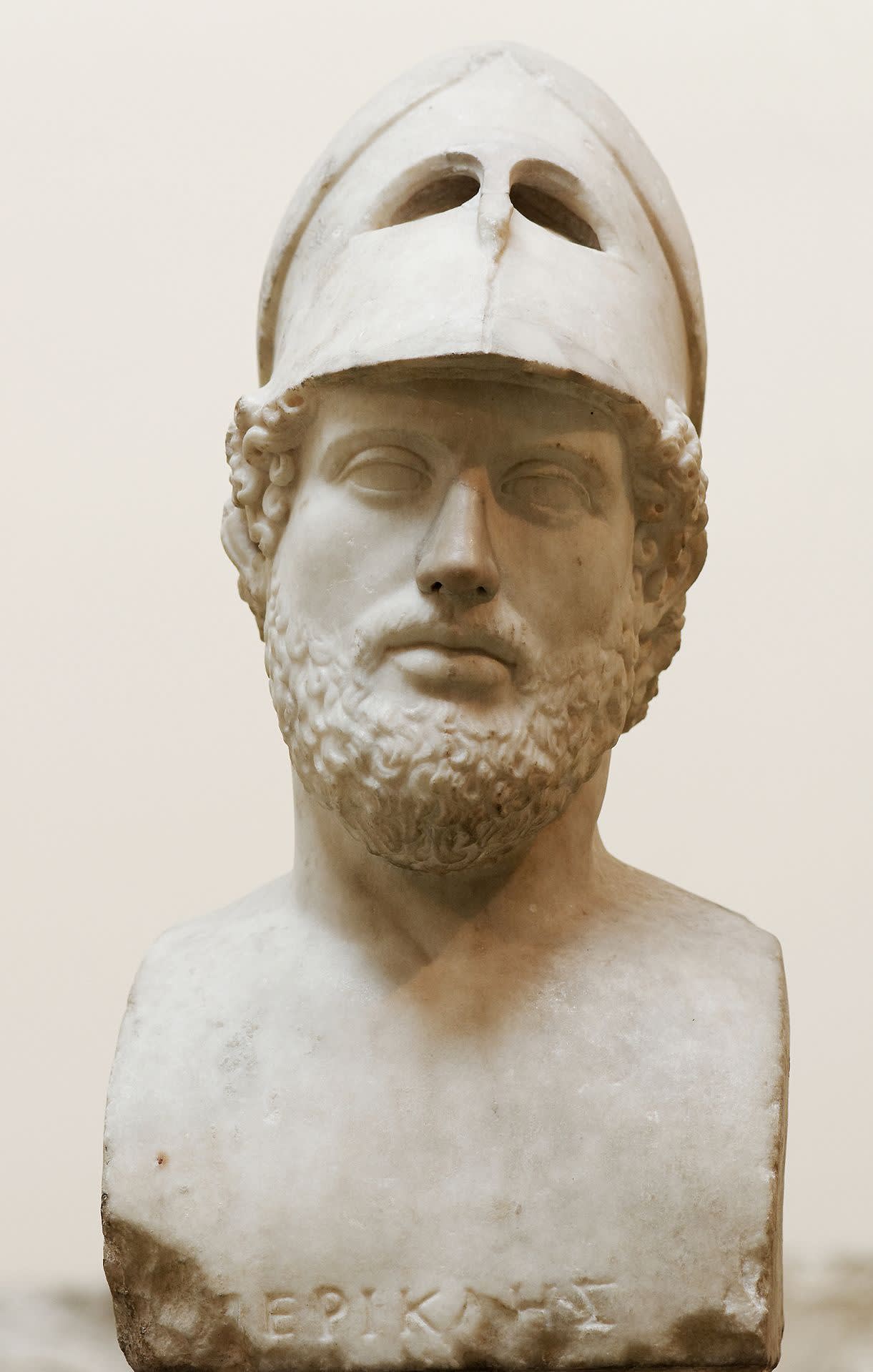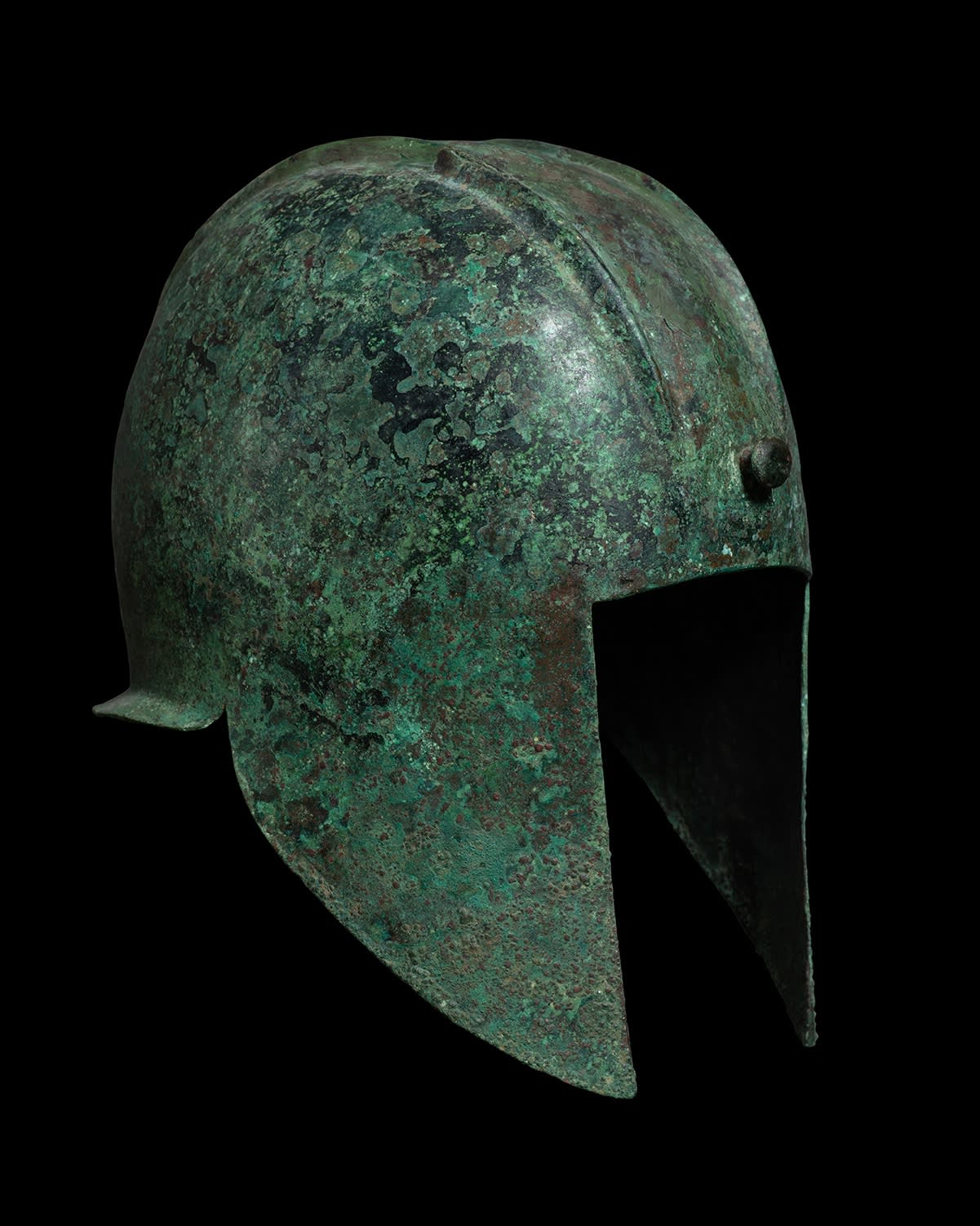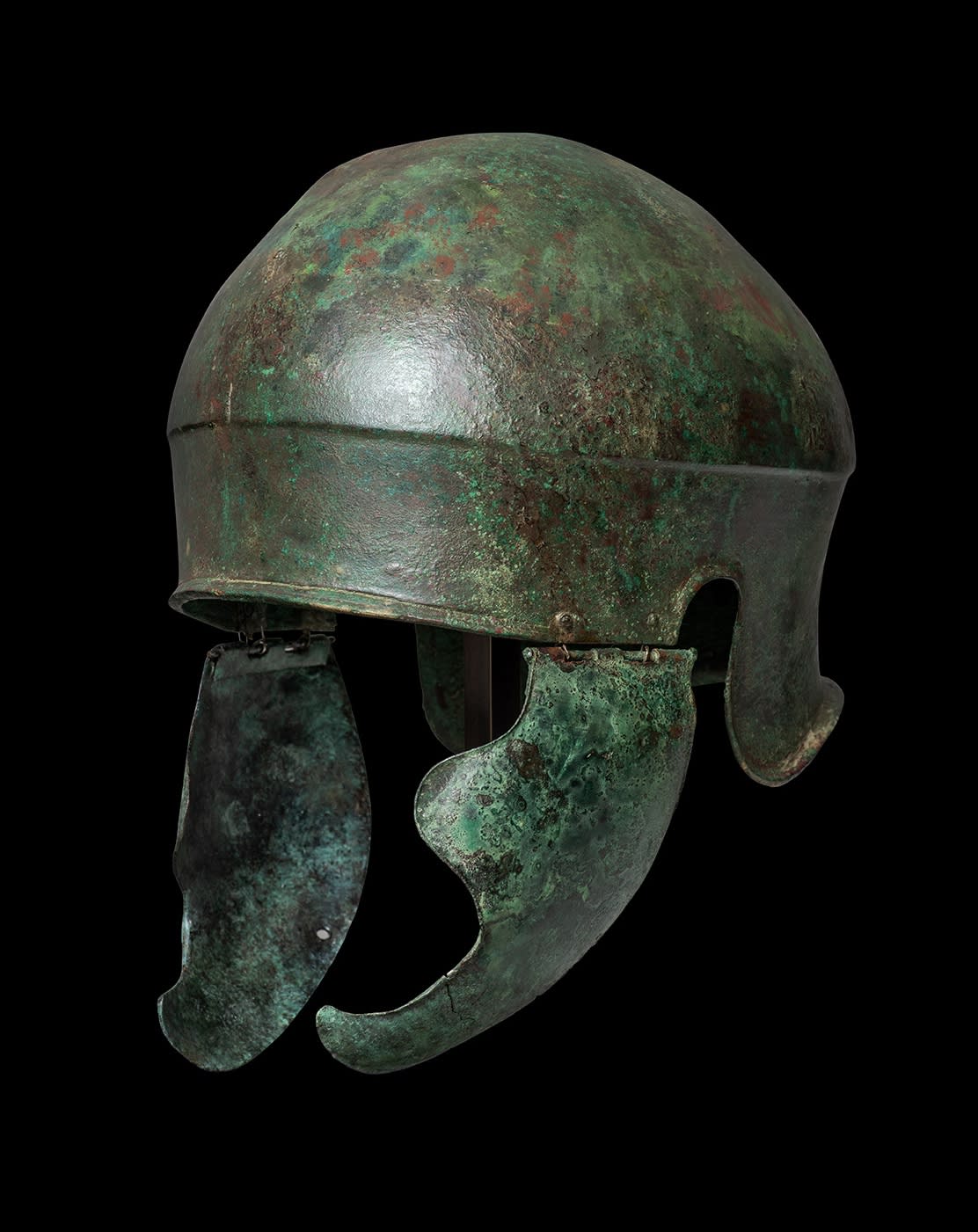"He stretched his arms towards his child, but the boy cried and nestled in his nurse’s bosom, scared at the sight of his father’s armour, and at the horse-hair plume that nodded fiercely from his helmet." Homer, The Illiad, 6.466-470

The history of the Greek helmet began in the 17th century BC with the Mycenaean boar helmet. However arguably it is the Corinthian helmet that has become one of the most recognisable emblems of Greek warfare, manhood and cultural identity. The Corinthian helmet was used from the late 8th century BC until the Classical Period. Its name derives from Herodotus (The Histories, 4.180), who first mentions the type and its connection with the goddess Athena. It refers generally to a form of helmet, which covered the head completely with holes for the eyes and a vertical slash at the mouth.

AN ATTIC BLACK-FIGURE NECK AMPHORA,
IN THE MANNER OF THE ANTIMENES PAINTER
Circa 525 - 500 BC
Large numbers of these helmets have been found throughout the Greek world. Their representation in a variety of media, especially in vase-painting and sculpture, also indicates that they were popular, ever-evolving, and made and used well beyond Corinth. The Greeks portrayed not only their real soldiers, but also their mythical heroes and their gods in these helmets. For example in vase painting, the Kallos Attic black-figure amphora attributed to the Antimenes Painter, depicts two hoplites wearing Corinthian helmets, probably the Homeric heroes Achilles and Memnon, fighting over the fallen body of Antilochus. In sculpture, perhaps the two most iconic depictions of the type are the famous portrait of the Athenian statesman Perikles and a colossal statue of the ‘Velletri Athena’. Both are High Classical works dating to the mid-5th century BC and are attributed to the sculptor Kresilas (though now preserved only in Roman copies).

A ROMAN MARBLE BUST OF PERIKLES, circa 2nd century AD
The British Museum,London, inv. no. 1805.7-3.91 (CC BY 2.5)

A ROMAN MARBLE BUST OF THE VELLETRI ATHENA
Circa 2nd century AD
The Glyptothek, Munich, Germany, inv. no. 213
Although the Corinthian helmet was incredibly strong as it was made from a single piece of bronze, it did have limitations. Firstly, it was very expensive to produce as each helmet had to be made specifically for each soldier. If the helmet did not fit perfectly over the hoplite’s head it could have deadly consequences. Secondly, the face was almost entirely covered by the long nose guard and two thick cheek guards that met over the mouth, leaving the wearer with severely restricted vision and hearing. It has been widely debated that the popularity of the Corinthian helmet may have delayed the invention of battlefield tactics, as communication would have been obstructed by its design.
Contemporary to the Corinthian helmet is the Illyrian helmet. This is a purely Greek form with its origins in the north-western Peloponnese of the early 7th century. Due to a number of early finds of such helmets on the eastern coast of the Adriatic Sea, the form became known as Illyrian. Similar to the Corinthian, this type covered the whole head and cheeks, but left the front open making it easier to hear. Made in two pieces of bronze soldered at the top it was slightly less costly to produce, however more vulnerable due to the weak seam. In order to attempt to solve this issue, the horsehair crest or plume was introduced. This crest ran from front to back concealing and strengthening the soldered top, as well as adding an imposing feature used to intimidate their enemies. This style of plume became a popular feature and was used for several centuries onwards.

A GREEK BRONZE HELMET OF ILLYRIAN TYPE
Circa 6th - 5th century BC
By the end of the 6th century BC, the Corinthian and Illyrian type helmets had been adapted in order to address their constraints and weaknesses. The first way this was achieved was by wearing the helmet pushed back on top of the head instead of over the face. This type is named the pseudo-Corinthian helmet and was developed in South Italy during the 6th-5th centuries BC. This style of helmet would have been secured with a chinstrap, with the front portion serving as a visor. The adaptation of this type from the original Corinthian allowed the wearer more visibility, as the eye and nose slits became purely decorative.

The Kallos pseudo-Corinthian helmet is a very fine example of the type and of particular note are its cheek pieces with incised details of the foreparts of confronting boars. The level of skilled craftsmanship evident from the decoration reminds us that these helmets were not just purely pieces of utilitarian armour. They also served as an emblem of a Greek soldier’s wealth and status. During the Archaic and Early Classical Periods, Greek soldiers had to purchase their own armour. Therefore the quality of the pieces they wore conveyed not only their military valour, but also their rank and place in society.
By the end of the 5th century BC the invention and introduction of battlefield strategy and tactics had encouraged Greek hoplites to prefer more open helmets with greater visibility. Therefore it is during this period that the Chalcidian type helmet grew in popularity. This type was developed as its lighter and more flexible design allowed for greater mobility. The Kallos example and others of the same type originate from the Greek colonies of South Italy. This form with hinged cheek-guards and without a nose-guard, became popular in the late 5th-early 4th century BC. The helmet would commonly have a hole pierced on each cheek piece or elsewhere in order to adhere an inner lining that was made of leather.

A GREEK BRONZE HELMET OF CHALCIDIAN TYPE
Late Classical Period, circa 5th - 4th century BC
The stylistic and practical advancement of helmets continued until the Romans invaded and conquered large parts of the Greek world. The Romans favoured lighter and more robust styles of helmet, and consequently the Greek examples above were slowly phased out.